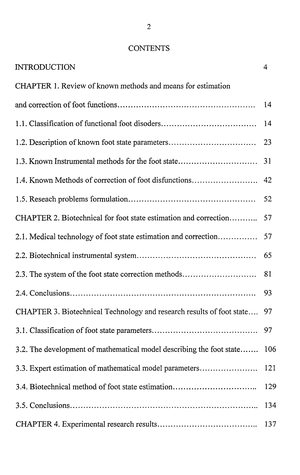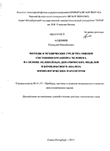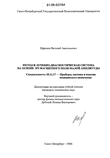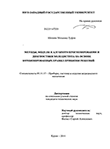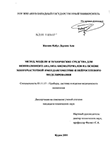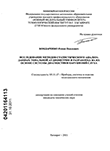Содержание к диссертации
Введение
CHAPTER 1. Review of known methods and means for estimation and correction of foot functions 14
1.1. Classification of functional foot disoders 14
1.2. Description of known foot state parameters 23
1.3. Known Instrumental methods for the foot state 31
1.4. Known Methods of correction of foot disfunctions 42
1.5. Reseach problems formulation 52
CHAPTER 2. Biotechnical for foot state estimation and correction 57
2.1. Medical technology of foot state estimation and correction 57
2.2. Biotechnical instrumental system 65
2.3. The system of the foot state correction methods 81
2.4. Conclusions 93
CHAPTER 3. Biotechnical Technology and research results of foot state 97
3.1. Classification of foot state parameters 97
3.2. The development of mathematical model describing the foot state 106
3.3. Expert estimation of mathematical model parameters 121
3.4. Biotechnical method of foot state estimation 129
3.5. Conclusions 134
CHAPTER 4. Experimental research results 137
4.1. Research program for foot estimation and correction 137
4.2. Results of experimental research 146
4.3. Recommendation for clinical usage 152
General conclusion 160
Address of thanks 163
References 164
Appendixes 173
- Description of known foot state parameters
- Biotechnical instrumental system
- development of mathematical model describing the foot state
- Results of experimental research
Description of known foot state parameters
Floor reaction force is measured by force plate [38]. Force plate is the device that measures the power caused in sole at the walking time, and a basic principle is the same as the platform scale. Therefore, to separate floor reaction force of a right and left leg, and to measure floor reaction force, two-force plate is needed. In force plate, the foot is first put and a floor thing that walking can do, in a word, the plate is necessary. Moreover, the device, which can perceive power, that is, the sensor, is necessary. As a general sensor, the board is supported in the pillar, and the function of the sensor has been provided for it. The part, which corresponds to this pillar, is a part same as the platform scale. In the point where force plate is different from a mere platform scale, each one of the pillar is an independent platform scale. Therefore, when the weight is supported in the plate, the size of the power, which support the power, and point of application
can be calculated because the distribution of the power applied to each pillar is understood. In addition, horizontal force can be measured by the pillar s bending in force plate though only the power of direction of vertical can be measured in a mere platform scale. The size of the action power and the method of obtaining point of application are as follows. I think about power, which supports the plate assumed the one not transformed with sagittal plane as shown in Fig. 1.3.1 think these are synthesized to one power though power, which supports the plate, is Fa,Fb .That is Moreover, the moment of power should be the same after synthesizes and before synthesizes. In a word, From two formulas above The size of application force can calculate power Fz after synthesizes and point of application as position lx of point of application [36]. Next, the pillar shortens being pushed, and will grow fat sideways though is a method of measuring power in the pillar when the pillar is pushed on. Power can be calculated by converting this phenomenon into an electric amount. The most general one is the one that strain gauge was used though there are many methods of conversion into an electric amount. In force plate, strain gauge is stuck on four metallic of each props, and a slight warp of a metallic prop is detected in electricity. If the harmony of four warps is taken, the vertical element which hangs to the metallic prop can be calculated, and if the difference of the warp of back and forth is taken, the bend to back and forth is understood. The element of the direction where floor reaction force progresses can be calculated by this [39]. The right and left are also similar. All particular functions are built in the pillar. 1.2-2. Electromyogram Electromyogram (below: EMG) is necessary to induce the stripe activity potential. The electrode used by the movement study uses the surface electrode though the needle electrode of the electrode used for a clinical diagnosis is general. When the electrode is installed and it moves, the surface electrode is not accompanied by the pain. Moreover, when it moves in man, and the operation is examined, it is the most practical because the activity potential from many different units of the movement can be induced at the same time. The surface electrode is silver as polarized electrode though can use the electrode for the electrocardiogram and the electrode for the brain wave -It is thought that the surface electrode that uses the chloridization silver electrode is the most suitable [40]. The electrode position is installed the separation of two electrodes on stripe venter which tries to be examined according to a stripe running by 2-3cm. When the electrode is put on the center of the stripe in the stripe of the spindle type so that potential may decrease when the electrode position parts from the center of venter, the maximum potential is obtained. The electrode installation part shaves hair and often risks dirt and the lipid of the skin in the acetone and alcohol [41]. It is necessary to do fixation enough so that the electrode should not peel off because of violent movement and perspiration, etc. when the electrode is fixed to the skin. A stripe activity in walking can be examined with a device of the electromyogram like the above-mentioned. Walking is a periodic movement, and many researchers, for example, Inman [42], are reporting the research that uses the electromyogram. The analysis method use foot switches to distinguish each phase of walking cycle stance phase and, in a word, swings phase, and double stance phase first of all. If the load of about 1.7kgf/cm joins paving and tape during putting tape switch in sportype shoes, this foot switch becomes on. And, the surface electrode is installed from rt. thigh in M. vastus medialis, M. vastus lateralis, M. rectus femoris, and M. hamstrings mediaris for instance. Moreover, M. vastus intermedius is pierced the bipolar fine-wire electrode of 30um in the diameter, connected with the print respectively, and derived. The system of the measurement and the analysis records with the data recorder, and analyzes the electric signal obtained from the living body. Those who experiment observe each shape of waves by the monitor scope, and record this shape of waves in a pen-and-ink recorder at the same time. Presence or the operation time etc. of the noise and artifact are examined based on this record and it refer to the processing afterwards. The obtained shape of waves does a smooth rectification about EMG, converts A/D, and processes the taking shape of waves to the computer. A pure moment that power is not applied to the bearing is shown by the term named torqeHowever, because the support power is generated in the joint of the bearing when the stripe acts in the living body, the term named torqe cannot be used. Then, when the support power is generated in the joint of the bearing, the term named joint moment is used [43]. This joint moment is explained by using Fig. 1.4 what generated. Fig. 1-4 is a scene to which the muscular power of the knee is measured with the spring scale. The value calculated with the spring scale is Fxa. When muscle force is assumed to be f, and the perpendicular length lowered from knee joint in the action line of muscle force is assumed to be b, it becomeFxa = /x6 from the balance of the moment of power. The right side of formula is a moment of muscle force. The moment of this muscle force is called joint moment [43].
Biotechnical instrumental system
The equipment used for the measurement, the parameter, and the method of statistical the result processing is described, and a bionics system that contains the meaning of the measurement is described.In the ROM measurement of the foot, goniometer (R361A, University of68Tokyo model goniometer) shown in Fig. 2.6 was used.
Details are described as follows though dorsi-flexion, plantar-flexion, eversion, and inversion were measured in an actual measurement. Ankle joint and the foot are leg of tibia and fibula, talus, calcaneus, Os naviculare, Os cuboideum, and Os cuneiforme latelare Os cuneiforme intermediam they consists of Os cuneiforme mediale, Os metatarsale 1-5, and 14 Ossa digitrorum pedis, and the movement measured by this research is articulatis talocruralis (Fig. 2.7) and articulatio subtalaris.
Articulatis talocruralis is ginglymus by which facies articularis inferior, malleolus medialis, and malleolus lateralis become fossa articularis, and trochlea tali of facies superior of tali is assumed to be caput articulae.This joint enables the movement of dorsi-flexion and plantar-flexion.
Articulatio subtalaris is joint with facies articularis talaris posterior of articularis calcaneus posterior of corpus tali and facies superior calcaneus anterior. This joint chiefly enables eversion (pronation, abduction, dorsi-flexion) and inversion (supination, adduction, plantar-flexion).
Pressure distribution on the sole used Parotec System made by the Paromed company, which consisted of contoroller unit shown in Fig. 2.8, insoles pressure pads, and the personal computer.
As for insoles, 24 sensors are composed of three phases of internal organs, heel contact phase (Sensors #1-6), support phase (Sensors #7-20), and push off phase (Sensors#21-24). The measurement principle is based on the law that the capacity of condenser changes when it hangs to the plate with two pressures, and the space between the plates is changed. And, to measure not only vertical pressure but also the horizontal pressure by using hidorocells for the sensor.
Measuring range is 6.25 N/cm2 and resolutional ability is 0.25 it is N/cm2 and measuring frequency is 10Hz-250Hz.Software can put out an average value, the maximum value of walking, and a value and the maximum value of each step. In the average value of walking, the time of measured steps and heel contact is displayed, and the average value of each sensor is displayed. Moreover, the decentralization of the weight pressure of another and (Fig. 2.9) walking to which the orbit of the COP is displayed as an orbit line can be displayed in a solid image in the method of the display. As for this, the maximum values and three patterns of lateral, medial, and posterial are displayed. Moreover, it is also possible to display the state of heel contact of each phase in the bar chart.
Statistics and academic processing of ROM change before and behind stretching and the pressure distribution on sole change used paired test of the parametric authorization. Concerning the data of the pressure distribution on sole, the data on five consecutive trials before stretching and those on 5 consecutive trials after stretching were compared in each subject, and statistical analysis was performed after rearrangement of the data, because no significant difference was observed between each of the 5 trials before and the respective trial after stretching.
It seems that the measurement in this research is meaningful assuming that grounds in the effect of stretching shown only in the sense and the experience are shown in the biomechanics. If this system is used, the improvement situation of the foot in standing and walking can be understood by enforcing the ROM measurement before and behind stretching and the pressure distribution on sole measurement, and confirming a numeric change in the data. The foot is considered to be the only segment of the body that touch the floor in standing and walking, therefore, and it is considered to exert major effect on the movement of the whole body. Also, the foot, which supports the entire body weight, control the body balance, and produce propelling force, has a complex structure, and these functions of the foot are considered to be affected even by slight restriction of the ROM or myalgia. It is not arduous in the imagination whether changing a few angle influences standing and walking for such a foot how much. I think that there is a meaning to select the ROM measurement of the foot from these as one of main parameters. Moreover, the base side is narrow in the foot compared with the body. A few unbalances can be easily imagined influencing changing pressure distribution on this narrow base side. The meaning was found to such a respect, and pressure distribution on the sole was added to one of main parameters.
And, I measured them as follows.The measurement of center of gravity of lateral balance of standing was barefooted done. Step length was assumed to be natural standing position, and the knee made progress completely. At this time, the case where the COG is more than 2cm before the center of malleolus lateralis (Here was assumed to be 0) was assumed to be normal [56].
After the direction of each movement had been practiced two times before and behind stretching, the ROM measurement of the foot was measured only once according to the ROM display which "The Japanese Orthpaedic Association" provided and the measurement method. The measured direction of the movement and the measurement posture were assumed dorsi-flexion (0-20) of ankle joint, plantar-flexion (0-45), eversion (0-20), and the inversion (0-30) as shown in Fig. 3.3. Moreover, dorsi-flexion of ankle joint and basic axis in plantar-flexion was assumed to be a perpendicular to axis of leg. And, moving axis was assumed to be Os metatarsale quintum and the axis core was assumed to be sole. As for basic axis in eversion of the foot and inversion, I assumed, and moving axis was made the intersection of the axis of a basic axis of sole and axis and the movements with the perpendicular to axis of leg. All these movements were assumed to be active exercise.
Pressure distribution on the sole is to try to measure to floor reaction force which can be shown only as a vector as distribution. If floor reaction force is made the product of the imagination, pressure pressure distribution is a product of practice. An apparatus for pressure distribution on the sole, which the author used, paves insole, which uses thin microsensor for pressure sensor in ballet shoes, and makes walk
development of mathematical model describing the foot state
Measurement of forward and backward balance and of the degree of ankle joint s dorsi-flexion indicated significant increases, and tension was focused on the significant increases in measurement values of pressure distribution on the sole by sensors No. 2 (heel) and 20 (MTP, or end of the toe) taken after stretching, and a mathematical model was developed as below. A. Measurement of range of motion of ankle joint. After stretching, degree of ankle joint s dorsi-flexion intentionally grew compared with in front of stretching. Additionally, the COP moved forward by measurement of forward and backward balance after stretching and subjects could be confirmed. By extending the M. triceps surae, we were able to surmise that the standing the COP would move forward and it is thought that this comprises a relationship between the effect of stretching and arch elevation. PWl . 0 Wl In short, because Hick s formula [90, 911 t = can be rewritten as — = —, L J QL P tl when one increases, the still standing position inclines forward, and the arch elevates. (Fig. 3.4). However, it is thought that Hick s formula [90, 91] can be correctly extrapolated only when the load center W by weight is near the ankle joint. As well as confirming this, I am carrying out calculations based on Hick s formula [90, 91] with the intent of introducing a method that is appropriate for these conditions, even in the event there is a change in either the height of the arch or the COP. The model in Fig. 3.5 is the foot while standing still on the floor. The model comprises two segments, and they are aligned at a single axis joint where there is no rubbing, which corresponds to the ankle joint. The right segment is called the toe segment and the left side is called the heel segment. Lt is length of toe segment, t is tension to beam tension rope, and L is the distance from the heel to the thenar eminence. Moreover, Weight is the , / is the distance from the heel to the line of weight-bearing P is the distance from thenar eminence to the line fo weight-bearing b is vertical element of floor reaction force which acts on thenar eminence h was assumed to be vertical element of floor reaction force which acted on heel and the height of the element was assumed to be Q the fingernail measured with the line of weight-bearing ahead. Joint force has acted on the point that two segments do collaboration as shown with Fig. 3.5. When the power applied to the toe segment is assumed to be F = (Fx, Fy), the power applied to the heel segment becomes - F = (- Fx, - Fy). Because, the power applied to the heel segment is: Ft = (t,b): applied to the thenar eminence, x element is a tension, у element is a floor reaction force; G = (0,-W) :wight-bearin, vertical, down ward; F = (Fx,Fy): joint force. All this combination power becomes zero because toe segment does not move at all either when subjects whom keep still standing position is assumed to be a geostationary state, which does not move now. Thus, joint force F newly introduced was described. In the same way, the power, which acts on the heel segment it, is
Because heel segment does not move as well as toe segment at all, either two-combination power becomes zero. Therefore I get This equation x element, у element, and respectively when solving Both of Fx are when this is compared with the expression of the balance of the xy direction concerning toe segment, and it is compatible. It should consist because Fy must be also compatible. whose downward power by weight is synthetic floor reaction force b + h. Moreover, it is understood for the foot not to be buried in floor, not to come to the surface. It is understood that the foot fits the floor. Next, it makes to start point О of the xy coordinate system, and the moment of all power will be shown though it is an expression of balance concerning the rotation by power by which it tries to rotate the object concerning this starting point О. Here, line of application of gravity by weight will be extended to floor, and the starting point of this coordinate system be taken in the COG which projects COM which intersects with floor to floor. At this time, coordinates of each point that power has acted on toe segment by the free body diagram are as follows. In general, when power F acts on position r, the moment by which the power tries to rotate the object can be drawn with rxF. Moreover, when the sign of X is assumed to be the outside product of the vector and the vector, the outside product of two vectors (x,y) in two dimensions and (X,Y) is vectors which turn in the direction of the normal (It is an orthogonal direction in the plane) in the two dimensions, and the size becomes (xY-yX). Therefore, the following formula can be used. The expression of this balance that the harmony of the moment where each power, which acts on the toe segment of the current model, is generated vanishes by formula becomes on a roll as follows.each paragraph at the left of formula was the moment of power which acts on toe, joints of the 2 segments and point of application of body weight from the left. I develop by using the official on the tip of these each paragraph, I requested by expression (3.6) and (3.7), and when =b + h is substituted by using expression (3.8) for Fx = , Fy-h, and b + h, the following expression is obtained. Similarly, coordinates of the point that power has acted on the heel segment are as follows. joint of toe and heel segments :» = (Lcosd- P, Lt sin в). The balance type of the moment of power is as follow.(1,0) x(,h) + (Ltcos0-P,L sind) x(-Fx,-Fy) = 0 (3.11) This develops; too the expression of final balance is obtained as follows by the assumption of (l + P) which appears to -Fx = t, -Fx = t, and the development expression (l + P) = L. Lh-L,hcos0-Lt sinO =0 (3.12) When the left side and the right side of above-mentioned type (3.11) and (3.12) are added mutually, the following relational expression is obtained.In a word, two lengths that related to weight and the given foot showed the power that acted on heel. Here, when expression (3.10) is transformed, it becomes the following.
Results of experimental research
The subjects were 5 normal females aged 20-26 years (mean 21.4±2.6 years), height (mean 159.4±3.9cm) and weight (49±5.5kg)who had regularly worn low-heeled (2cm or less) shoes for at least 6 months.
If the COG dropped in front of 2cm of malleolus lateralis, it was assumed it was normal, and was based in the measurement of the COG on this. The patient with a hard joint of the whole body shows the tendency for the COG to drop to the vicinity of malleolus lateralis in a person of movement shortage and longerm hospitalization, etc. in the experience of the author. Notes in this measurement are to take the same posture before and behind atretching. Concretely, the belly is put and projects, and the heart is put. Next, the power of the shoulder is pulled out, geostationary standing is taken by about 30 seconds, and I measure it. It seems that reliability lowers if it is not a measurement after this is defended.
The result of the COG measurement, which was measured before and behind stretching based on the center of malleolus lateralis and given official approval, was as follows.
When measuring forward and backward balance while standing as viewed from the COG line, movement of the COP from 3.3 cm to 4.8 cm forward was confirmed in all samples, and a significant difference (P 0.001) was recognized. Because, It was 1.74±1.13cm before stretching and 5.92±1.42cm behind stretching (Table Appendix-1).
Next, behind stretching, there was significantly increased ROM after dorsi-flexion, inversion, and eversion, with no significant difference in plantar-flexion. After the direction in each movement of dorsi-flexion of foot joint by active exercise, plantar-flexion, eversion, and inversion had been practiced twice according to the ROM display, which "The Japanese Orthpaedic Association" provided, and the measurement method, the measurement of the ROM was measured only once. Moreover, I assumed, and sole of moving axis was axis with os metatarsal quintum to basic axis in dorsi-flexion of ankle joint and plantar-flexion with the perpendicular to axis of leg. As for basic axis in eversion of the foot and inversion, I assumed, and sole and axis made moving axis the intersection of basic axis and moving axis with the perpendicular to axis of leg. Notes in this measurement are to measure at the angle of same knee flexion in consideration of the stripe it by which two joints are stepped over. Moreover, I think that should refuse to the patient, mark from the skin to moving axis and axis with the pen, and have reproducibility certainly. In particular, it was an acknowledged that an abstention rate of 1% for dorsi-flexion was very significant, and it is suggested that elevation of the arch is because of increasing ankle joint dorsi-flexion.
The result of the ROM measurement was as follows.The mean angle of voluntary extension was 18.6±2.41 in the left and 17.8±2.68 in the right before stretching and 23.4+1.34 and 23.2±1.92, respectively, behind stretching. The values in both feet were significantly greater (p 0.01) behind stretching. The mean angle of flexion was 65.4±3.26 in the left and 65.2±4.07 in the right before stretching and 66.6±2.42 and 66.2±3.49, respectively, after the ROM ex. No significant difference was observed in either foot. The mean angle of inversion was 60.6±4.88 in the left and 61.2±3.56 in the right before stretching and 61.8±4.38 and 62.8±3.56, respectively, behind stretching. The values after stretching were significant greater (p 0.05) in both feet. The mean angle of eversion was 32.8±4.09 in the left and 34±2.92 in the right before stretching and 36.2±5.02 and 36.4±4.04, respectively, behind stretching. The values behind stretching were significantly greater (p 0.05) in both feet (Table Appendix-2-a, Table Appendix-2-b).
The measurement of pressure distribution on sole did three walking practice on the walking road of 15m, made walk five times by the real thing afterwards, and made pressure distribution which hung to ten steps worth of right and left, sole an analysis object. Moreover, to walk as fast as possible, walking under the measurement was directed. It is a point to make notes in this measurement-acquired walk to extent not tired fast. It is necessaiy to have the experience to running but walking to the end fast. Moreover, it is necessary to relax without becoming hard because it is easy to walk the best purpose. I think that speaking as can the challenge even if failing times how many is important for that.
In analytical channel, the author thought that stretching was able to judge if they met all each standard of three measurements as effective.
In masurement of the COG I assumed more than two cm of malleolus lateralis to be normal at the case where there is the COG ahead.In the measurement of the ROM, dorsi-flexion (0-20) of ankle joint, plantar-flexion (0-45), eversion (0-20), and inversion (0-30) were made a normal range, abnormality of eversion with dorsi-flexion and dorsi-flexion movement was a case among those below a normal range, and it was based.
The average value of the maximum value of each Sensor selected in 24 Sensor in measurement of pressure distribution on sole was as follows. 24 sensors are divided into three phases of heel contact phase (Sensors #1-6), support phase (Sensors #7-20), and push off phase (Sensors#21-24).
The result of measurement of pressure distribution on sole was as follows.Average maximum values of sensors No. 2 and No. 20 were as follows:In sensor No. 2 in the posterior part of the plantar, pressure was 42.73+2.89N in the left and 44.21±2.79N in the right before stretching, and 46.12±3.00N and 46.40±2.17N respectively behind stretching. This showed significant increases (pO.001 in the left, p 0.02 in the right) behind stretchin. In sensor No. 20 in the middle part of the plantar, the pressure was 23.82±3.90N in the left and 21.87±2.22N in the right before stretching, and 27.10+2.97N and 24.07±2.45N, respectively, behind stretching; showing significantly increases (p 0.001) behind stretching in both feet (Table Appendix-3-a, Table Appendix-3-b).
The biomechanical research was performed in this work concerning the effect of foot stretching when walking and standing. As the result the suppositions about PC movement forward in pathological changes of the foot arch both when standing and walking were made. Besides this, two biotechnical systems were developed and a set of exercises was selected for correction of foot range of motion. The following results can be referred to the main results of the work:1. Research method of human foot behavior in different modes of feet operation application of wich allowed to obtain new data on foot behavior. These data enlarged (widened)our present view of the interaction processes of different body parts at standing.2. New data on foot behavior in different operation conditions allowing to connect the foot range of motion with the elevation of its arch and to reveal the impact of other parts of human body on maintaining vertical position of the body at standing and walking.3. Establishment of the relation between the movement of the body gravity center (forward and backward) when leaning forward and elevation of the foot arch which can be registered with the help of transducers.4. Mechanical and mathematic model of foot operation explaining interaction of foot elements when maintaining equilibrium at standing and walking. These models were constructed on new data about the body elements interaction.5. A set of specially selected exercises for foot stretching with the aim of improvement of its range of motion, that are collected in the database containing all necessary data about their usage. The approaches to formation of final set of such exercises which allow to influence the foot arch elevation and thus judge objectively about the improvement of its range of motion were considered. Application of such exercises leads both to significant and fast relieving of RROM and myalgia syndrome and to significant improvement of ankle function.6. Two modifications of biotechnical complex of RROM diagnostics, one of which is meant for performing scientific research, and the other is meant for clinical

